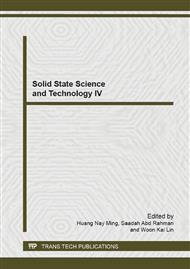p.291
p.298
p.305
p.311
p.315
p.319
p.323
p.334
p.338
Mass Attenuation Coefficients and Effective Atomic Numbers of Strontium Borate Glass System in the Energy Range 0.01- 1.25 MeV
Abstract:
Understanding the characterization of photon interaction is vital in nuclear science and technology field. The information obtained from mass attenuation coefficients (μ / ρ) and effective atomic numbers Zeff are compared with the reference value for good interpretation of radiation interaction with matter. However, the methods of Zeff calculation sometimes are confusing. In the present work, the total mass attenuation coefficients (μ / ρ) T for photon interaction of Dy2O3 doped strontium borate glasses have been calculated using database tabulated by Hubbell and Seltzer, at the energies of 0.6 MeV and 1.25 MeV. For the calculation of the Zeff, the power law, cross section and Auto-Zeff are selected for comparison purpose in the energy range of 0.01 – 1.25 MeV. The relationship between the (μ / ρ) T and Zeff clearly shows the increase in the value with the increase of Dy2O3 concentration. These variations are due to the major dominance of photoelectric effect and minor interaction of incoherent scattering. It is found that the calculation of Zeff between cross section and power law method is comparable at photon energy less than 0.1 MeV. As photon energy exceeds 0.1 MeV, the cross section method and the Auto- Zeff software are more preferred compared to the power law approach. It is recommended to use different approach of Zeff calculation at the specific energy of interest.
Info:
Periodical:
Pages:
315-318
Citation:
Online since:
February 2014
Authors:
Price:
Сopyright:
© 2014 Trans Tech Publications Ltd. All Rights Reserved
Share:
Citation:


